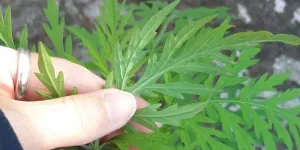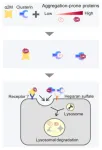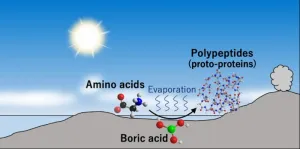(Press-News.org) The common ragweed plant (Ambrosia artemisiifolia) has spread rapidly in Europe and has intensified the pollen season for many allergy sufferers. Now the plant has arrived in Norway.
Common ragweed can extend Norway's pollen season into November, but fortunately the species is struggling in this country.
“Common ragweed can be found in Norway, but for now it has no stable populations,” says Vanessa Carina Bieker, a postdoc at the Norwegian University of Science and Technology's (NTNU) University Museum Department of Natural History.
Last autumn Bieker discovered ragweed in Oslo. The Norwegian alien species list counts it as a low-risk plant since it has not yet properly established itself in Norway.
For now, the country’s climate is probably too tough for the plant, but increased temperatures could help it survive here too. It has already established itself in large parts of the world.
Supergenes are inherited together
Now researchers have found that special supergenes have helped ragweed to adapt to Europe. The supergenes are a main reason that the plant is able to adapt to new conditions so readily.
“These supergenes are large blocks of genes that are inherited as a unit by the next generation. These supergenes affect the plants' characteristics, such as their size or when they flower, and are in turn important for the plants to be able to survive and reproduce under new climate conditions,” says Michael D. Martin, a professor and expert in genetics at the Department of Natural History in the NTNU University Museum.
The researchers from the museum collaborated with scientists from several other institutions, including Monash University in Australia, and especially Dr. Kathryn Hodgins. The research team recently presented their findings in an article in Nature Communications.
Invasive species are a major environmental problem
Common ragweed’s home turf is actually North America, but the plant found its way to Europe in the 19th century, probably through imported seeds and horse feed.
Alien, or invasive, species that spread into areas where they do not belong are among the world's biggest environmental problems. These new species destroy the balance that already exists between species in an area.
Invasive species can have major consequences at the expense of local plants and animals, such as the spread of toads, rabbits and dromedaries in Australia – along with common ragweed. Wild dogs and cats are a problem for species diversity in several parts of the world.
“We have to learn how invasive species evolve and spread before we can learn to control them. Then we can counteract the damage they do and limit their effect on species diversity, the economy and our health,” says Martin.
Important to study the genetic material
Studying plants’ genetic material is an important part of the fight against invasive species.
“When we identify the changes in DNA that enable such invasive species to spread so quickly, we gain a new weapon in our arsenal when we have to fight them,” says Bieker.
Bieker is also an expert in genetics. The research team identified the entire genetic code in over 600 plants in order to detect these genetic changes. They found most of the plant specimens in herbariums and various museum collections in North America and Europe. Some of the specimens were as much as 190 years old.
“When you compare these old specimens with the living plants you find outside today, you can also identify the changes in the genetic material that have taken place over the years. And this helps pinpoint which genes have contributed to common ragweed spreading so quickly,” says Bieker.
The investigations show which gene variants dominate under different climate conditions, and which parts of the genetic material change over time.
Supergenes dominate in Europe
Among the researchers’ most important discoveries is that the plants from the home continent of North America and those from Europe are different in important ways.
This finding involves basic genetics and evolutionary theory. When the conditions around the plant change, such as when they arrive on a new continent, some genes can give individual plants advantages at the expense of others.
Plants with these advantageous genes are more effective at reproducing. The advantageous genes are thus more often passed on to the next generation.
“The supergenes in the European plants enabled them to evolve rapidly during the invasion,” says Martin.
The supergenes enabled ragweed to colonize large parts of the continent by changing characteristics such as their size and the timing of their life cycle.
“These are properties that have had a major impact on ragweed’s success and therefore the planst’ production of highly allergenic pollen,” Martin says.
Importance of museum collections
The methods used by the researchers are completely new. Genetics is a field that has developed very rapidly in recent years. These methods would not have been possible just a few years ago.
The study also shows how novel genetic methods can be applied to old scientific collections to obtain completely new and enlightening results.
“This research shows the power in studying old specimens in herbariums and other museum collections. They can inform us about the recent spread, and sometimes very rapid evolution, of invasive species that have been strongly influenced by human activity,” says Martin.
Perhaps these research findings will help keep the common ragweed at bay. Allergy sufferers can at least hope.
Reference: Battlay, P., Wilson, J., Bieker, V.C. et al. Large haploblocks underlie rapid adaptation in the invasive weed Ambrosia artemisiifolia. Nat Commun 14, 1717 (2023). https://doi.org/10.1038/s41467-023-37303-4
END
Supergenes helped bring invasive plant to Norway
Learning how super-invasive organisms manage to thrive in new environments can help us learn to limit their spread
2023-05-11
ELSE PRESS RELEASES FROM THIS DATE:
How “extracellular chaperones” help remove abnormal proteins
2023-05-11
Proteins tend to fold wrongly and become defective when exposed to stressors such as heat, oxidation, and pH changes. Accumulation of abnormal proteins contributes to neurodegenerative diseases like Alzheimer’s.
So, how does the human body deal with such misfolded or defective proteins? It regulates protein networks via a process called ‘proteostasis,’ which prevents protein aggregation and any damage that may result from misfolded protein accumulation inside (intracellular) or outside (extracellular) cells. A set of unique proteins—molecular chaperones—play an essential role in proteostasis: they target and interact with misfolded proteins, maintain their solubility, ...
Therapy sessions benefit mothers, children in homeless shelter
2023-05-11
Short-term therapy sessions with parents and their children in homeless shelters could help improve parenting skills and reduce parental stress and children’s post-traumatic stress symptoms, according to a pilot study published by the American Psychological Association.
Researchers from Florida International University partnered with Lotus House in Miami, one of the largest women’s homeless shelters in the U.S. The study included 144 families (mother and one child) with children from 18 months to 5 years of age. The research was published online in the Journal ...
Sleep apnea associated with increased risk for long COVID
2023-05-11
Sleep apnea may significantly increase the risk for long COVID in adults, according to a study led by the National Institutes of Health’s RECOVER Initiative and supported by NYU Langone Health as home to the effort’s Clinical Science Core (CSC).
As of April 2023, more than 100 million Americans had been infected with the virus that causes COVID-19. As of April the U.S. Government’s Household Pulse survey estimated that about 6 percent of U.S. adults are experiencing symptoms associated with long COVID, including brain fog, fatigue, depression, and sleep problems. ...
A dangerous eye infection from tainted eye drops, months before the CDC’s warning
2023-05-11
HIGHLIGHTS
Pseudomonas aeruginosa is a pathogenic and drug-resistant gram-negative bacterium
The CDC advised against using some artificial tear eye drops that were contaminated with the microbe
In November 2022, doctors in Cleveland diagnosed a patient with a corneal ulcer with a P. aeruginosa infection
The patient acquired the infection from tainted eye drops months before the CDC’s February 2023 warning
Washington, DC – In February 2023, the Centers for Disease Control and Prevention warned people against using EzriCare eye drops because bottles of the product had ...
Brigham experts provide insights on how Alzheimer’s drug lecanemab slows cognitive decline
2023-05-11
WHO: Dennis Selkoe, MD, co-director of the Ann Romney Center for Neurologic Diseases at Brigham and Women’s Hospital and corresponding author of the paper in Neuron. Andrew Stern, MD, PhD, of the Ann Romney Center for Neurologic Diseases at BWH and first author of the paper in Neuron
WHAT: In a report published in Neuron, a team led by investigators from Brigham and Women’s Hospital reveals the structure of the therapeutic target of lecanemab, a drug approved by the US Food and Drug Administration in January 2023 for the treatment of Alzheimer’s disease. While the ...
Traditional medicine plant could combat drug-resistant malaria
2023-05-11
Much of what is now considered modern medicine originated as folk remedies or traditional, Indigenous practices. These customs are still alive today, and they could help address a variety of conditions. Now reporting in ACS Omega, a team of researchers have identified compounds in the leaves of a particular medicinal Labrador tea plant used throughout the First Nations of Nunavik, Canada, and demonstrated that one of them has activity against the parasite responsible for malaria.
“Labrador tea” refers to multiple, closely related plants — all members of the genus Rhododendron. ...
ESO telescope reveals hidden views of vast stellar nurseries
2023-05-11
Using ESO’s Visible and Infrared Survey Telescope for Astronomy (VISTA), astronomers have created a vast infrared atlas of five nearby stellar nurseries by piecing together more than one million images. These large mosaics reveal young stars in the making, embedded in thick clouds of dust. Thanks to these observations, astronomers have a unique tool with which to decipher the complex puzzle of stellar birth.
“In these images we can detect even the faintest sources of light, like stars far less massive than the Sun, revealing objects that no one has ever seen before,” says Stefan Meingast, an astronomer at the University of Vienna in Austria and lead author ...
Majority of nurses attribute well-being struggles to staffing shortages
2023-05-11
Cross Country Healthcare, Inc. (NASDAQ: CCRN), a market-leading, tech-enabled workforce solutions platform and advisory firm, in collaboration with Florida Atlantic University, today announced the results of its annual survey of nursing professionals and students.
The study found that although nurses are passionate about doing meaningful work and earning a good income, only one-third of nurses plan to remain in the profession for the foreseeable future, and about one-fourth plan to leave in just one to two years from now. The survey, conducted in collaboration with FAU’s Christine E. Lynn College of Nursing, found ...
Researchers uncover how primordial proteins formed on prebiotic earth
2023-05-11
How did catalytic organic polymers emerge on prebiotic Earth? Answering this essential question will unlock key understandings in the origin of life.
A team of scientists at Tohoku University have recently found a potential environment for the reaction that produced catalytic organic polymers. To do so, they dried down amino acid solutions containing boric acid and found that boric acid catalyzes polypeptide synthesis under neutral and acidic conditions. The longest peptides formed in the experiments were 39 monomer-long glycine polypeptides under a neutral condition.
Previous studies ...
Women with hardened arteries may need stronger treatment to prevent heart attacks than men
2023-05-11
Barcelona, Spain – 11 May 2023: Postmenopausal women with clogged arteries are at higher risk of heart attacks than men of similar age, according to research presented at EACVI 2023, a scientific congress of the European Society of Cardiology (ESC),1 and published in European Heart Journal - Cardiovascular Imaging.2 The study in nearly 25,000 adults used imaging techniques to examine the arteries and followed patients for heart attacks and death.
“The study suggests that a given burden of atherosclerosis ...
LAST 30 PRESS RELEASES:
Beech trees use seasonal soil moisture to optimize water uptake
How thinning benefits growth for all trees
Researchers upgrades 3-PG forest model for improved accuracy
Achieving anti-thermal-quenching in Tb3+-doped glass scintillators via dual-channel thermally enhanced energy transfer
Liquid metal modified hexagonal boron nitride flakes for efficient electromagnetic wave absorption and thermal management
Failure mechanisms in PEM water electrolyzers
Study captures how cancer cells hide from brain immune cells, shows that removing their “don’t eat me” signals stops their escape
New breakthrough in detecting ‘ghost particles’ from the Sun
Half of people arrested in London may have undiagnosed ADHD, study finds
From dots to lines: new database catalogs human gene types using ’ACTG’ rules
Persistent antibiotic resistance of cholera-causing bacteria in Africa revealed from a multinational workshop for strengthening disease surveillance
SwRI, Trinity University to synthesize novel compound to mitigate effects of stroke, heart attack
Novel endocrine therapy giredestrant improves disease-free survival over standard of care for patients with early-stage breast cancer in phase III lidERA trial
Gen Z views world as "scary place" with growing cynicism about ability to create change
Biosensor performance doubled – New applications possible
Leveraging incomplete remote sensing for forest inventory
Key chemical in dark chocolate may slow down ageing
New 15-minute hepatitis C test paves the way for same-day treatment
Uranus and Neptune might be rock giants
Magnetically actuated soft electrodes for multisite bioelectrical monitoring of ex vivo tissues
FAU engineers decode dementia type using AI and EEG brainwave analysis
Carrier-free peptide–daunorubicin–small interfering RNA nanoassembly for targeted therapy of acute myeloid leukemia
Global Virus Network announces appointment of new board members
Artificial beaver dams show promise in offsetting climate change effects
Could hidden infections be fueling long COVID?
Targeted oxygen for initial resuscitation of preterm infants
Researchers develop models to help diagnose ALS earlier through blood biomarkers
Jeonbuk National University researchers develop novel eco-friendly and photo-switchable smart adhesives
Magnetic ordering induces Jahn–Teller effect in spinel-type compounds
A mitochondrial protein may hold the secret to longevity, new study finds
[Press-News.org] Supergenes helped bring invasive plant to NorwayLearning how super-invasive organisms manage to thrive in new environments can help us learn to limit their spread





